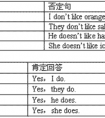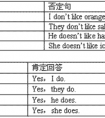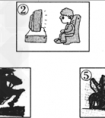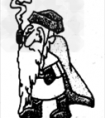按要求写句子。1. He does well in maths.(改为否定句) _________________________________________________2. Mike is shorter than me. (改为同义句) _______________-六年级英语
题文
| 按要求写句子。 |
| 1. He does well in maths.(改为否定句) _________________________________________________ 2. Mike is shorter than me. (改为同义句) _________________________________________________ 3. — ____ ________________________(根据答句提问题) — I play the piano. 4. This computer is my father's. (对画线部分提问) _________________________________________________ 5. There are some old men in the classroom.(改为单数句) _________________________________________________ 6. I go to school by bus every day.(用Mike替换I) _________________________________________________ |
答案
| 1. He doesn't do well in maths. 2. I'm taller than Mike. 3. What do you usually do after school? (答案不唯一) 4. Whose computer is this? 5. There is an old man in the classroom. 6. Mike goes to school by bus every day. |
据专家权威分析,试题“按要求写句子。1. He does well in maths.(改为否定句) ______..”主要考查你对 规则形容词的比较级,单数名词,疑问代词,一般现在时,动词单数第三人称,助动词 等考点的理解。关于这些考点的“档案”如下:
规则形容词的比较级单数名词疑问代词一般现在时,动词单数第三人称助动词
考点名称:规则形容词的比较级
- 当我们需要对事物作出比较时,需要用到比较级。
比较级的句子结构通常是:
什么 + 动词be (am , is , are ) + 形容词比较级 + than(比)+ 什么 ,意为:“比……更……”。 如:
I’m taller and heavier than you. (我比你更高和更重。)
An elephant is bigger than a tiger. (一只大象比一只老虎更大。) - 形容词的比较级变化规则:
形容词的比较级是在形容词的基础上变化而来的,规则形容词的比较级变化规则是:
① 一般的直接在词尾加er ,如 tall - taller , strong - stronger ,
② 以e结尾的,直接加r ,如 fine – finer ,
③ 以辅音字母加y结尾的,先改y为i再加er,如funny - funnier
④ 双写最后的字母再加er,如big – bigger, thin – thinner ,
hot – hotter
下表举例列举一些形容词的原级和比较级。
原级 比较级 long longer large larger dry drier big bigger hot hotter
考点名称:单数名词
单数名词:
主要用来表示“一个”东西的概念。两个及其以上就应用复数名词来描述。
例如单数可数名词:man,river,book,glass,desk,cup,road,car,eye,foot,tree,bird,girl,boy英语上名词按可数与否可分为可数名词和不可数名词。
可数名词按数目又可分为单数名词和复数名词两类。
注意:不可数名词没有复数形式,如water(水)。
考点名称:疑问代词
- 疑问代词:
在句子中用来构成特殊疑问句,主要用于询问“何人”、“何事”、“什么”。
常见的疑问代词如下表所示:
疑问代词
替代范围
who
人
whom
人
whose
人
which
人、事、物
what
事、物
考点名称:一般现在时,动词单数第三人称
一般现在时:
表示现在经常反复发生的动作、存在的状态或习惯性的动作的时态。可概括为
①经常性或习惯性动作;
②长期存在的特征或状态;
③普遍真理、客观事实等。
构成:
一般现在时用行为动词的原形,但第三人称单数作主语时,动词的词尾要加-S。
a. 表示经常性或习惯性的动作。
例:Li Ming always helps the old man. 李明一直帮助这位老人。
We usually go to school on foot. 我们通常步行上学。
They sometimes go fishing on Sundays. 他们有时周日去钓鱼。
b. 表示永恒不变的事实或真理。
例:A bird flies with wings. 鸟用翅膀飞翔。
c. 用在格言、谚语中。
例:Pride goes before a fall. 骄者必败。- 一般现在时具体用法:
1.表示经常的或习惯性的动作,常与表示频率的时间状语连用。
时间状语:
always,usually,every morning/night/evening/day/week/year,often,sometimes,
occasionally,from time to time,twice a week,rarely,seldom,once a month,hardly,ever,never.
e.g: I leave home for school at 7:00 every morning.
2.表示主语具备的性格、能力、特征和状态。
e.g:I don't want so much.
Ann Wang writes good English but does not speak well.
比较:Now I put the sugar in the cup.
I am doing my homework now.
3.表示客观事实和普遍真理。
e.g :The earth moves around the sun.
Shanghai lives in the east of China.
4.在时间状语从句和条件状语从句中,常用一般现在时代替将来时。
5.表示预先计划或安排好的行为。
6.小说故事用一般现在时代替一般过去时。新闻报道类的内容,为了体现其“新鲜”性,也用一般现在时来表示过去发生的事情。
7.有些表示状态和感觉的动词表示现在发生的具体行为时,只用一般现在时,而不用进行时态。
8.表示现在发生的具体动作或存在的状态
9表示格言或警句中。 e.g Pride goes before a fall. 骄者必败。
注意:此用法如果出现在宾语从句中,即使主句是过去时,从句谓语也要用一般现在时。
例:Columbus proved that the earth is round..
第一句用一般现在时,用于操作演示或指导说明的示范性动作,表示言行的瞬间动作。
再如:Now watch me,I switch on the current and stand back.
- 最新内容
- 相关内容
- 网友推荐
- 图文推荐
| [家长教育] 孩子为什么会和父母感情疏离? (2019-07-14) |
| [教师分享] 给远方姐姐的一封信 (2018-11-07) |
| [教师分享] 伸缩门 (2018-11-07) |
| [教师分享] 回家乡 (2018-11-07) |
| [教师分享] 是风味也是人间 (2018-11-07) |
| [教师分享] 一句格言的启示 (2018-11-07) |
| [教师分享] 无规矩不成方圆 (2018-11-07) |
| [教师分享] 第十届全国教育名家论坛有感(二) (2018-11-07) |
| [教师分享] 贪玩的小狗 (2018-11-07) |
| [教师分享] 未命名文章 (2018-11-07) |



![Myuncleisforty, buthe ____________thanmyfather.[ ]A. lookyoungB. lookslikeyoungC. looksyoungerD. looksgettingyoung-六年级英语](http://www.00-edu.com/d/file/ks/4/1/30/2019-08-17/smallddb860e524a845aa74ac06d29a7422b81565981628.png)


